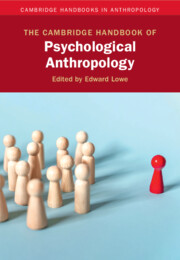Book contents
- The Cambridge Handbook of Psychological Anthropology
- Cambridge Handbooks in Anthropology
- The Cambridge Handbook of Psychological Anthropology
- Copyright page
- Dedication
- Contents
- Figures
- Table
- Contributors
- 1 Psychological Anthropology in its Second Century
- Part I Theoretical Foundations
- Part II Methodological Innovations
- 6 Mixed Methods in Psychological Anthropology
- 7 Methods in Cognitive Anthropology
- 8 Person-Centered Ethnography
- 9 Visual Psychological Anthropology
- Part III Lifespan Development in Diverse Sociocultural Contexts
- Part IV Body, Emotion, Self, and Experience
- Part V Postcolonial and Political–Economic Interventions
- Index
- References
7 - Methods in Cognitive Anthropology
from Part II - Methodological Innovations
Published online by Cambridge University Press: 22 October 2025
- The Cambridge Handbook of Psychological Anthropology
- Cambridge Handbooks in Anthropology
- The Cambridge Handbook of Psychological Anthropology
- Copyright page
- Dedication
- Contents
- Figures
- Table
- Contributors
- 1 Psychological Anthropology in its Second Century
- Part I Theoretical Foundations
- Part II Methodological Innovations
- 6 Mixed Methods in Psychological Anthropology
- 7 Methods in Cognitive Anthropology
- 8 Person-Centered Ethnography
- 9 Visual Psychological Anthropology
- Part III Lifespan Development in Diverse Sociocultural Contexts
- Part IV Body, Emotion, Self, and Experience
- Part V Postcolonial and Political–Economic Interventions
- Index
- References
Summary
This chapter discusses the development of methods in cognitive anthropology. It documents how these methods developed from a focus on documenting shared cultural knowledge to a period where the person returned as a primary locus of cultural experience. The chapter’s discussion is organized into three overlapping historical periods. The ethnoscience period involved strategies for the elicitation of cultural domain taxonomies, componential analyses, and methods that allowed the identification of prototypical members of a category or subcategory. The cognitive schemas period used more structured data collection methods to document cultural schemas that organize items in a cognitive domain and statistical methods for modeling their interrelations. Cognitive anthropologists also developed ways to document cultural schemas in everyday talk, mainly using the method of semi- and unstructured extended interviews and life histories. The cultural models period used structured and unstructured data collection methods and quantitative and qualitative data analysis from the cultural schemas research period. These methods were used to connect culture to variations in individual experience.
Keywords
Information
- Type
- Chapter
- Information
- The Cambridge Handbook of Psychological Anthropology , pp. 177 - 200Publisher: Cambridge University PressPrint publication year: 2025
